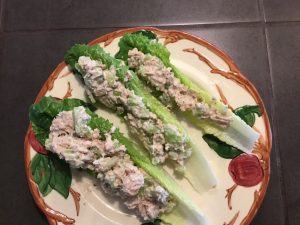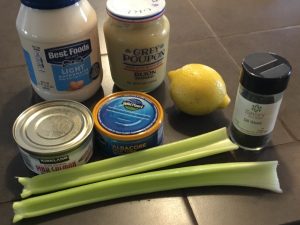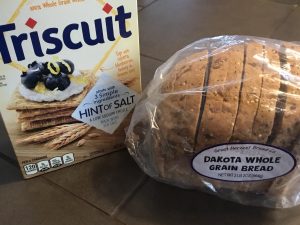Canned Salmon or Tuna for a Fast, Tasty Meal
Canned tuna and salmon are great, easy ways to get those omega three fatty acids our blood vessels like. They are also excellent protein sources. You might say “Yuck, Canned Fish???” But think again there are ways to make these quite delicious. Here’s a quick recipe that can use either type of fish, OR leftover baked or grilled fish of any kind.
This is a healthy recipe for anyone, but especially for anyone who needs to track their carbohydrates (people with diabetes, or those needing to limit carbohydrates for whatever reason).
Salmon or Tuna Salad
- Start with one 5 or 6 ounce can of salmon or tuna (I find the most economical brands come from Costco)
- Chop 2 stalks of celery and add to fish
- Add 2 tablespoons light or regular mayonnaise (I tend to use light, just to save a few calories—35 calories/TBSP for light vs 100 calories/Tbsp for regular—use what you like!) + 1 teaspoon Dijon mustard + about 1/2 teaspoon dill weed.
- Mix well and eat in bread as a sandwich, on top of lettuce, or on top of a green salad with crackers on the side.
- My favorite bread is Great Harvest Dakota Bread. It is made from whole grains, tastes great and holds up well for a tuna or salmon salad sandwich. A tasty cracker is Triscuits.They are made from 100% whole wheat. The “Hint of Salt” variety has a little salt sprinkled on top, but has only 50 mg sodium per 6 cracker serving.
Calculating carbohydrates for someone who takes insulin:
- The tuna or salmon and mayonnaise have no carbohydrates.
- The celery and lettuce don’t have enough to count.
- Each 2 ounce slice of Dakota Bread has 22 gm carbohydrates (with 4 gm fiber); read the label for your bread.
- 6 Triscuits have 20 gm carbohydrates (with 3 gm fiber).
- If you are very hungry or will be very active after your meal, eat two slices of bread or 12 crackers.
- Add a piece of fruit to round out your meal and give you some ‘sweet’. Depending on size, fruit will add anywhere from 15 to 36 gm carbohydrate and 2 to 6 gm fiber—4 ounce apple vs 9 ounce pear. Weigh your fruit and look up carbs on an app such as ‘Calorie King’).
Fiber is very important for helping regulate blood glucose; it is a carbohydrate that is not all absorbed. Including fiber in a meal helps keep your blood glucose from going up very fast.
- When you eat a meal that has MORE THAN 5 gm FIBER in it, SUBTRACT 50% of the fiber from your total carbohydrates.
- Salmon salad with two ribs of celery and 4 large romaine leaves (0 carbohydrate and 4 gm fiber from the celery and lettuce)
- 2 slices of Dakota bread (total 44 gm carbohydrate and 8 gm fiber)
- Large pear ( 36 gm carbohydrate and 6 gm fiber),
- Total meal contains 80 gm carbohydrate and 18 gm fiber; subract 9 gm from your total carbohydrate to get a net of 71 gm carbohydrate
- This sounds complicated. BUT, by learning to be accurate with carbohydrates, your will be able to be more exact with calculating your insulin needs. This, in turn, will help you keep that blood glucose where you want it.
There is no RIGHT amount of carbohydrate for a person with diabetes who is on insulin; but you do need to know how much carbohydrate you will eat in a meal so that you can take amount of insulin your body needs.
If you have pre-diabetes or diabetes, and are on “oral” medicine or non-insulin shots:
You don’t have to carefully track the amount of carbohydrate you are eating, BUT you do want to aim for carbohydrates that are high in fiber. The bread, crackers and fruit in the meal above are great ways for you to get your carbohydrates. You will need more carbohydrates on days when you are very active, and fewer on days when you are doing more sitting. There is NO MAGIC NUMBER of carbohydrates for a person with diabetes.
Problems with eating and or calculating carbohydrates and insulin?
Make an appointment with a Registered Dietitian-Nutritionist (RDN) or Certified Diabetes Educator (CDE)! An RDN or CDE can help you figure out what is causing your blood glucose levels to be out of range. They can then give you the tools you need to better manage it.



